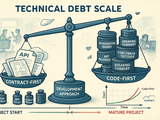Programming
Contract-First vs. Code-First Development: Why API Contracts Matter From Day One
Kotlin Extensions for LangChain4j
Keeping Your Software Healthy: The Critical Role of Dependency Updates
Spring Boot Starters
Code-Review Best Practices
Code review is a crucial practice in software development. One can design and write great software, but we are humans after all. And all humans make mistakes, so another pair of eyes is always helpful.
The review process might seem straightforward, but there are useful tips to make it less painful is some cases.
Running Testcontainers On Dynamic Ports
Running integration tests locally with Docker can be challenging when fixed ports are unavailable due to conflicts. This issue is compounded in shared CI environments where multiple workers are in use. However, using testcontainers can help overcome these obstacles by enabling the startup of Docker containers that listen on random ports.
Spring Boot Configuration Best Practices
What happens when you split systems into many microservices
Moving from monolithic applications into microservices is current trend in software design. Let’s identify some pros and cons of both architectures and challenges one may face during the system transformation.








